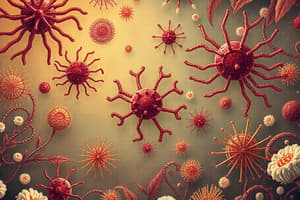Podcast
Questions and Answers
What is the characteristic of Bacillus anthracis colonies?
What is the characteristic of Bacillus anthracis colonies?
- Medusa-head appearance (correct)
- Curved or spiral form
- Motile with silver impregnation
- Ground-like appearance with Giemsa stain
Which of the following Clostridium species is not a cause of disease in sheep?
Which of the following Clostridium species is not a cause of disease in sheep?
- C.villorum (correct)
- C.perfringens
- C.chauvoei
- C.novyi
Which of the following bacteria is sensitive to gamma bacteriophage B.piliformis?
Which of the following bacteria is sensitive to gamma bacteriophage B.piliformis?
- Clostridium perfringens
- Clostridium spiroforme
- Bacillus anthracis (correct)
- Bacillus piliformis
What is the name of the vaccine used to protect against Bacillus anthracis?
What is the name of the vaccine used to protect against Bacillus anthracis?
Which of the following Clostridium species is a cause of disease in rabbits?
Which of the following Clostridium species is a cause of disease in rabbits?
What is the characteristic shape of Clostridium tetani colonies?
What is the characteristic shape of Clostridium tetani colonies?
What is the primary mechanism of action of tetanospasmin?
What is the primary mechanism of action of tetanospasmin?
What is the primary difference between proteolytic and nonproteolytic types of Clostridium botulinum?
What is the primary difference between proteolytic and nonproteolytic types of Clostridium botulinum?
What is the primary feature of Clostridium septicum colonies grown in deep agar?
What is the primary feature of Clostridium septicum colonies grown in deep agar?
What is the primary use of alum-precipitated formalinized whole cultures of Clostridium haemolyticum?
What is the primary use of alum-precipitated formalinized whole cultures of Clostridium haemolyticum?
Flashcards are hidden until you start studying
Study Notes
Bacillus Anthracis and Anthrax Disease
- Herbivorous animals are highly susceptible to anthrax disease
- Medusa-head colonies with a ground-like appearance
- Resistant to 5% phenol or mercuric chloride
- Sterne vaccine is used to prevent anthrax
- Sensitive to penicillin, lacks motility, and sensitive to gamma bacteriophage B.piliformis
- Tyzzer’s disease in lab rodents is caused by B. piliformis
Clostridium Species
- Motile and can be stained with Giemsa stain or silver impregnation
- Sensitive to penicillin
- Clostridium spiroforme has a curved or spiral form
Invasive or Enterotoxigenic Clostridia
- C. perfringens: causes lamb dysentery, struck, and pulpy kidney disease in sheep
- C. haemolyticum: causes bacterial icterohemoglobinuria or redwater disease in cattle
- C. novyi: causes black disease in sheep
- C. chauvoei: causes blackleg in cattle and sheep
- C. colinum: causes ulcerative enteritis or quail disease
- C. spiroforme: causes spontaneous and antibiotic-induced enterotoxemia in rabbits
- C. villorum: causes subcutaneous abscess in cats
- C. difficile: causes antibiotic-induced enterocolitis in hamsters
Toxin-Forming, Noninvasive Group
- C. tetani: causes tetanus, characterized by anaerobic spore-bearing bacilli
- Colonies are fluffy, cottony spheres
- Produces 3 toxins: tetanospasmin (neurotoxin), hemolysin, and a peripherally active nonspasmogenic toxin
- Tetanospasmin prevents the release of glycine
- Drumstick in appearance
- Sensitive to penicillin, resistant to aminoglycosides
C. botulinum
- Causes botulism, characterized by flaccid paralysis and eventual death due to respiratory failure
- Nonproteolytic types acidify but do not coagulate milk
- Proteolytic types slowly curdle milk, partially digest and darken the curd
- Lamziekte or lame disease arises from ingestion of contaminated food with preformed toxin
- Aphosphorosis may cause cattle and sheep to develop a depraved appetite for decaying carcasses, leading to botulism
The Tissue-Invading and Enterotoxigenic Group
- C. perfringens: from a decomposing human cadaver in which the tissues were gaseous
- Bacillus aerogenes capsulatus is widespread in soil and found in the alimentary tract in tissues of bloating cadavers of animals
- Rapidly liquefies gelatin but not coagulated egg medium or Loeffler’s blood serum
- Toxins are identified by serum-neutralization tests in mice and guinea pigs
C. haemolyticum
- Colonies grown in deep agar are lenticular at first and later become wooly
- Predilection for alkaline water and associated with pastures that contain swampy areas
- The most characteristic lesion is the large infarct that is always found in the liver
- Alum-precipitated formalinized whole cultures are used for immunization of cattle
C. novyi
- C. novyi type C is not toxigenic or pathogenic for animals
- One of the largest of anaerobic bacilli
- Requires cysteine in its reduced form
- Growth is poor in broth, but good in cooked-meat medium
- Found in the soil and in the intestinal tract of herbivorous animals
- Causes gas gangrene and black disease (necrotic hepatitis) of cattle
C. chauvoei
- Causes blackleg in ruminants
- Blackquarter, quarter evil, and symptomatic anthrax in cattle
- Causative agent of parturient gas gangrene in sheep
- Grows well on liver-brain medium
- Cattle are susceptible between 6 months and 2 years
- Entry is by the oral route during grazing
- Fluorescent antibody technique is used
- Penicillin is effective in treating blackleg if administered systemically and locally into the lesion
C. septicum
- Malignant edema bacillus and causes malignant edema in animals
- Colonies are grown in deep agar and are usually cottony and filamentous
- Produces 4 toxins: alpha, beta, gamma, and delta
- Guinea pigs are very susceptible
Studying That Suits You
Use AI to generate personalized quizzes and flashcards to suit your learning preferences.




